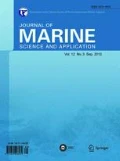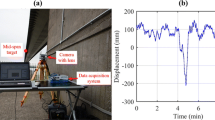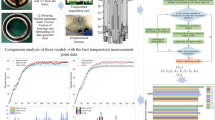Abstract
Propeller blade width measurement has been extensively studied in the past using direct and indirect methods, and it plays a great role in determining the quality of the finished products. It has surveyed that previous techniques are usually time-consuming and erroneous due to a large number of points to be processed in blade width measurement. This paper proposes a new method of measuring blade width using two images acquired from different viewpoints of the same blade. And a new feature points matching approach for propeller blade image is proposed in stereo vision measurement. Based on these, pixel coordinates of contour points of the blade in two images are extracted and converted to real world coordinates by image algorithm and binocular stereo machine vision theory. Then, from the real world coordinates, the blade width at any position can be determined by simple geometrical method.
Similar content being viewed by others
References
Bartoli A, Sturm P (2005). Structure-from-motion using lines: Representation, triangulation, and bundle adjustment. Computer Vision and Image Understanding, 100(3), 16–441.
Carlton JS (1994). Marine propellers and propulsion. Butterworth Heinemann, 28–54.
Davis J, Nehab D, Ramamoothi R (2005). Space time stereo: a unifying framework for depth from triangulation. IEEE Trans. On Pattern Analysis and Machine Intelligence, 27(2), 296–302.
Fujisawa N, Nakamura Y, Matsuura F, Sato Y (2006). Pressure field evaluation of microchannel junction flows through PIV measurement. Microfluidics and Nanofluidics, 3, 447–453.
Fujisawa N, Verhoeckx M, Dabiri D, Gharib M, Hertzberg J (2007). Recent progress in flow visualization techniques toward the generation of fluid art. Journal of Visualization, 10(2), 163–170.
International Standards Organization (1981). Shipbuilding Ship Screw Propeller Manufacturing Tolerance, ISO 3715-1978 (E), 1st edn-1981-08-15.
Kiuchi M, Fujisawa N, Tomimatsu S (2005). Performance of a PIV system for combusting flow and its application to a spray combustor model. Journal of Visualization, 8(3), 269–276.
Lam MK, Lee SF, Iovenitti P, Masood H (2002). A cost and effective thickness measurement technique for engine propellers. International Journal of Advanced Manufacturing Technology, 20, 180–189.
Matsuura F, Fujisawa N (2008). Anaglyph stereo visualization by the use of a single image and depth information. Journal of Visualization, 11(1), 79–86.
Okada K, Inaba M, Inoue, H (2003). Integration of real-time binocular stereo vision and whole body information for dynamic walking navigation of humanoid robot. IEEE Conference on Multisensor Fusion and Integration for Intelligent Systems, Tokyo, 131–136.
Rother C, Carlsson S (2002). Linear multi view reconstruction and camera recovery using a reference plane. International Journal of Computer Vision, 49(2/3), 117–141.
Slama CC (1980). Manual of Photogrammetry. 4th ed. American Society of Photogrammetry, Falls Church, Virginia, 447–451.
Soloff S, Adrian R, Liu ZC (1997). Distortion compensation for generalized stereoscopic particle image velocimetry. Measurement Science and Technology, 8, 1441–1454.
Tsai RY (1987). A versatile camera calibration technique for high-accuracy 3D machine vision metrology using off-the-shelf TV cameras and lenses. IEEE Trans. on RA, 3(4), 323–344.
Zhang GX (2000). The trend in development of coordinate measuring machines. Chinese Mechanical Engineering, 11(2), 222–227.
Author information
Authors and Affiliations
Corresponding author
Additional information
Foundation item: Supported by the Natural Science Foundation of China (50975133) and the Innovative Foundation for Ph.D of the Jiangsu Province, China (2010-227).
Jiande Zhang was born in 1982. He is a Ph.D candidate at Nanjing University of Technology. He received his M.S. degree in computer application technology in 2008 from Nanjing University of Technology. His current research interests include propeller optimization design and measurement, etc.
Jingui Lu was born in 1966. He is a professor at Nanjing University of Technology. He received the Ph.D degree from Huazhong University of Science and Technology, Wuhan, China in 1994. He received the M.S. degree in 1990. He received the B.S. degree from China University of Mining and Technology, Xuzhou, China in 1987. He was a postdoctoral researcher at Tokyo Institute of Technology from 1998 to 1999. He was a visiting professor at Utah State University in 2007. His current research interests include mechanical optimization design, etc.
Rights and permissions
About this article
Cite this article
Zhang, J., Lu, J. Measuring propeller blade width using binocular stereo vision. J. Marine. Sci. Appl. 10, 246–251 (2011). https://doi.org/10.1007/s11804-011-1065-2
Received:
Published:
Issue Date:
DOI: https://doi.org/10.1007/s11804-011-1065-2




